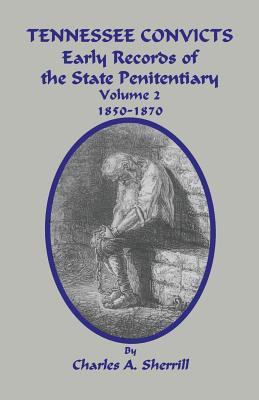Over 3,000 entries from 1850 with crimes listed from petty theft to murder. Includes personal details of convicts (also family/birth information). This second volume of Tennessee Convicts includes records of more than 3,000 inmates in the Tennessee State Penitentiary from 1850 through 1870. During this period the prison saw many changes, most notably the influx of military prisoners during the Civil War and a dramatic increase in African-American incarcerations in the years after the war. These records are excellent resources for the historian and genealogist. Despite their surface uniformity, these entries speak volumes about the history of the period. The fact that nearly every prisoner was pardoned by Reconstruction Governor William G. Brownlow, including, for example, Ned Dow, a "colored" prisoner from Weakley County convicted of rape in 1866, explains in part why Browniow was so despised by the former Confederates of the state. The imprisonment of Confederate guerillas such as Lincoln County physician John Woods, and of disobedient Union soldiers like William Conklin of the l0th Ohio, reflects the difficulties of the times. Prison officials rarely entered personal comments into the record, but occasionally appear to have been compelled to put their opinions on paper. For example, the entry describing R.H. Treadway, a printer convicted of petit larceny, includes this note: "Carried to this end like a great many others from a life of dissipation, visiting houses of ill fame and other similar places (groceries, gambling, saloons)." The larcenous habits of James Tilton earned him this remark: "Fifth sentence, and should he live he may come the sixth time.... He is naturally prone to steal." Most of this information was abstracted from ledgers 86 and 87 of the Tennessee State Penitentiary records (Record Group 25) at the State Library and Archives in Nashville. Volume 87 is arranged in a tabular format, giving basic information about each prisoner including name, age, place of birth, date received, county from which committed, crime, sentence, and discharge information. Volume 86 is in freehand and, although repeating much of the same information, also often includes notes about the prisoner's family and a physical description (the latter not included in this abstract). Because these manuscript records begin to be very sketchy during the Civil War period and contain many gaps thereafter, the published reports of the Penitentiary which were submitted to the Tennessee General Assembly were culled for information about prisoners from 1865-1870. The amount of detail about each prisoner provided in these published reports varies from year to year, but in general resembles that found in ledger 87. These reports may all be found at the Library and Archives, bound with the House and Senate Journals. Underlining has been added to confirm peculiar spellings, and [brackets] indicate text supplied by the transcriber, with question marks added where the original was unclear.

Tennessee Convicts: Early Records of the State Penitentiary 1850-1870. Volume 2
Over 3,000 entries from 1850 with crimes listed from petty theft to murder. Includes personal details of convicts (also family/birth information). This second volume of Tennessee Convicts includes records of more than 3,000 inmates in the Tennessee State Penitentiary from 1850 through 1870. During this period the prison saw many changes, most notably the influx of military prisoners during the Civil War and a dramatic increase in African-American incarcerations in the years after the war. These records are excellent resources for the historian and genealogist. Despite their surface uniformity, these entries speak volumes about the history of the period. The fact that nearly every prisoner was pardoned by Reconstruction Governor William G. Brownlow, including, for example, Ned Dow, a "colored" prisoner from Weakley County convicted of rape in 1866, explains in part why Browniow was so despised by the former Confederates of the state. The imprisonment of Confederate guerillas such as Lincoln County physician John Woods, and of disobedient Union soldiers like William Conklin of the l0th Ohio, reflects the difficulties of the times. Prison officials rarely entered personal comments into the record, but occasionally appear to have been compelled to put their opinions on paper. For example, the entry describing R.H. Treadway, a printer convicted of petit larceny, includes this note: "Carried to this end like a great many others from a life of dissipation, visiting houses of ill fame and other similar places (groceries, gambling, saloons)." The larcenous habits of James Tilton earned him this remark: "Fifth sentence, and should he live he may come the sixth time.... He is naturally prone to steal." Most of this information was abstracted from ledgers 86 and 87 of the Tennessee State Penitentiary records (Record Group 25) at the State Library and Archives in Nashville. Volume 87 is arranged in a tabular format, giving basic information about each prisoner including name, age, place of birth, date received, county from which committed, crime, sentence, and discharge information. Volume 86 is in freehand and, although repeating much of the same information, also often includes notes about the prisoner's family and a physical description (the latter not included in this abstract). Because these manuscript records begin to be very sketchy during the Civil War period and contain many gaps thereafter, the published reports of the Penitentiary which were submitted to the Tennessee General Assembly were culled for information about prisoners from 1865-1870. The amount of detail about each prisoner provided in these published reports varies from year to year, but in general resembles that found in ledger 87. These reports may all be found at the Library and Archives, bound with the House and Senate Journals. Underlining has been added to confirm peculiar spellings, and [brackets] indicate text supplied by the transcriber, with question marks added where the original was unclear.